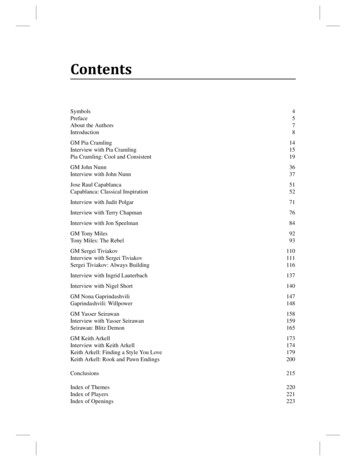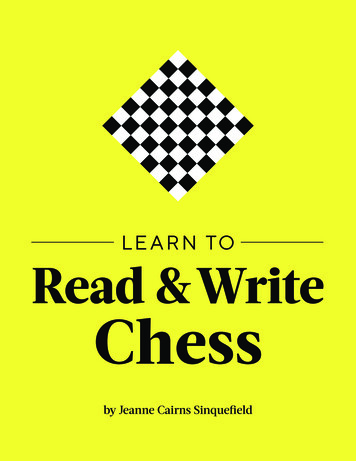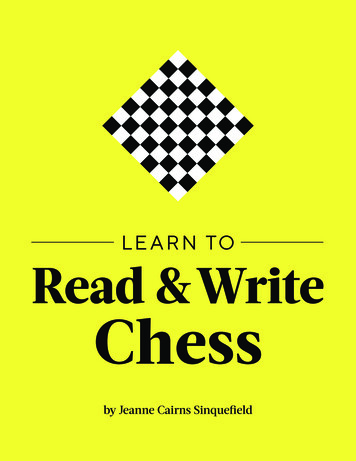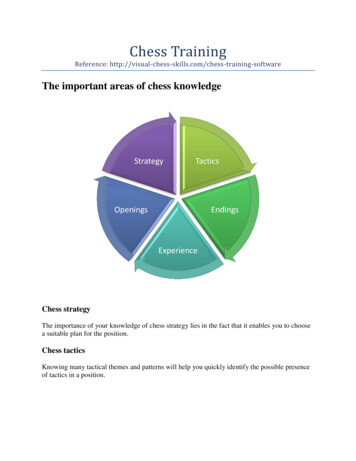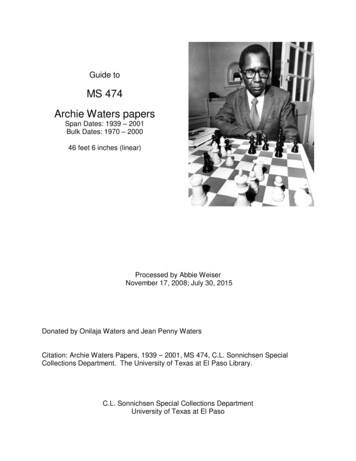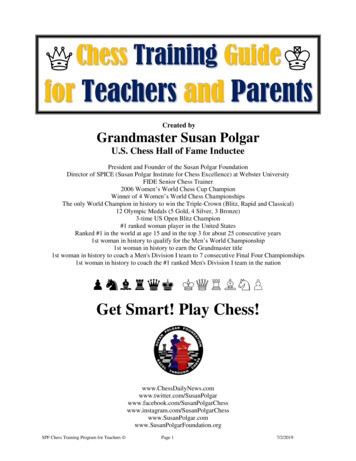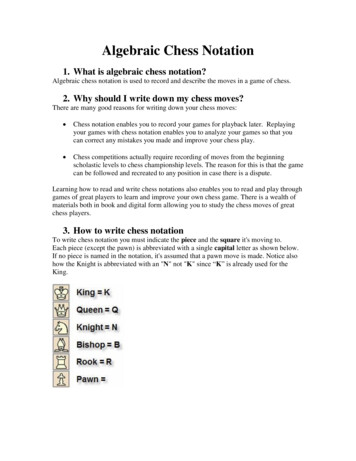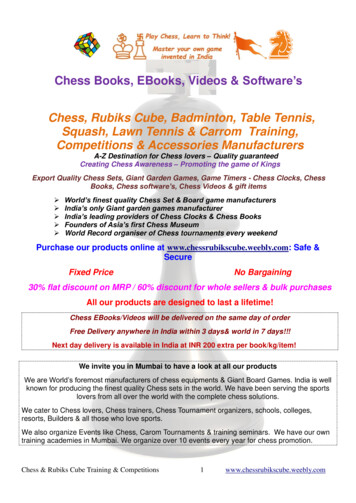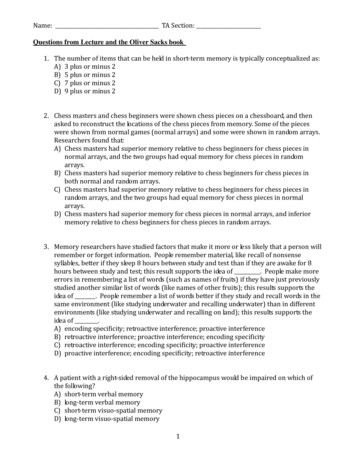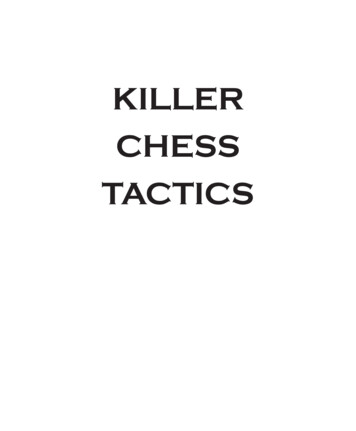
Transcription
KILLER CHESS TACTICS CARDOZA PUBLISHINGKILLERCHESSTACTICS1
KILLER CHESS TACTICS CARDOZA PUBLISHINGAbout the AuthorsLEONID SHAMKOVICHGrandmaster Leonid Shamkovich was born in Russia in 1923 and has lived in the United Statessince 1976. Grandmaster Leonid Shamkovich, former US Open Champion and two-time RussianChampion, is one of the most respected authorities on chess sacrifices and tactics. He quickly becamea powerful force in American chess winning the US Open and many major tournaments. Shamkovichhas written on the subject of chess tactics and opening theory for over 40 years, and his work hasappeared in every major chess journal. He has also served as an assistant or trainer for many of the verybest chess players.RAYMOND KEENEGrandmaster Raymond Keene, multiple tournament winner, and former British Champion, isthe world’s most prolific chess writer, with more than 100 books to his credit. Considered one ofthe strongest players in the world and one of the top theoreticians, Keene is well known for his workorganizing world championships, his many best-selling chess titles, and for his co-authorship withWorld Champion Garry Kasparov and Eric Schiller on Batsford Chess Openings—the all-time bestselling reference work on chess openings.Keene was the first British player to achieve a FIDE Grandmaster norm, was a member of eightOlympic chess teams, was a medal winner in the chess Olympiad, and was awarded the title ofOfficer of the British Empire by Queen Elizabeth II for his services to chess. He has been the chesscorrespondent for the Spectator, London since 1977, and Thames Television since 1986. He alsowrites the London Times daily chess column.ERIC SCHILLEREric Schiller, widely considered one of the world’s foremost chess analysts, writers, and teachers, isinternationally recognized for his definitive works on openings. He is the author of 100 chess booksincluding Cardoza Publishing’s series on openings, Gambit Chess Openings, World Champion Openings,Standard Chess Openings, and Unorthodox Chess Openings — an exhaustive opening library of morethan 2500 pages.Schiller is a National and Life Master, an International Arbiter of F.I.D.E., and the official trainerfor many of America’s top young players. He has recently been reappointed as official coach ofAmerica’s best players under 18 to represent the United States at the Chess World Championships. Hehas also presided over world championship matches dating back to 1983.Schiller’s web site is www.ericschiller.com; he is the senior editor of the free online chess magazine,www.chesscity.com.2
KILLER CHESS TACTICS CARDOZA PUBLISHINGKILLERCHESSTACTICSRaymond KeeneLeonid ShamkovichEric SchillerCardoza Publishing3
KILLER CHESS TACTICS CARDOZA PUBLISHINGFREE ONLINE CHESS MAGAZINEwww.chesscity.comGo online and visit our free chess magazine, which includes articles, columns, gossip andmore. The web’s most interesting and informative chess magazine is free to you from CardozaPublishing!Chess City is a sprawling metropolis of chess information, a magazine with the latest newsand analysis, where you can find gossip, trivia, and many fun features. Travel around the world tovisit the most fascinating chess competitions, preview books long before they hit the chelves andread informative coluns on openings, middlegames, endings, tactics, strategies, mates, and muchmore.Chess City is the newest and most exciting chess web site on the World Wide Web. You’ssbe able to catch up on the latest news and find out where the tournaments are, get secret tipsfrom top professionals and trainers, read about the exploits of the WHiz Kids, and delve into thehistory and personalities of teh chess world. View games online with commentary by Cardozaauthors, or download chess games annotated with words, not heiroglyphics.Copyright 2003 by Raymond Keene, Leonid Shamkovich, and Eric Schiller- All Rights Reserved First EditionLibrary of Congress Catalog Card No: 2003100600ISBN: 1-58042-111-3CARDOZA PUBLISHINGP.O. Box 1500 Cooper Station, New York, NY 10276email: cardozapub@aol.com(800) 577-WINSwww.cardozapub.com4
KILLER CHESS TACTICS CARDOZA PUBLISHINGTABLE OF CONTENTSABOUT THE AUTHORS2INTRODUCTION11INTRODUCTION TO TACTICS13OVERVIEW OF TACTICS15TYPES OF TACTICS17TACTICS FOR ATTACKING PIECES19Discovered Attack19Discovered Check20Windmill21Smothered Mate22ForkThe Knight ForkThe Family ForkThe Bishop ForkThe Rook ForkThe Queen ForkThe King Fork23232426272828Interference29PinAbsolute PinRelative Pin3031335
KILLER CHESS TACTICS CARDOZA PUBLISHINGTerminal PinSt. Andrew’s CrossOblique CrossTriple Pin35353637Removing the Defender37Trapping PiecesTrapped KnightTrapped BishopTrapped RookTrapped QueenTrapped King383838394041X-Ray Attack and Skewer42TACTICS FOR ATTACKING THE KING45Destroying the Barrier45Double Check47Pursuit48Perpetual Check48Harassment49TACTICS FOR CONTROLLING SQUARES51Blocking51Choke52Clearance53Square Clearance57Rank Clearance58File Clearance586
KILLER CHESS TACTICS CARDOZA PUBLISHINGDiagonal Clearance59Deflection59Decoy61MISCELLANEOUS tionUnderpromotion6767Rook Lift68TACTICS IN ACTION71Paul Morphy71Wilhelm Steinitz76Emanuel Lasker82Jose Raul Capablanca86Alexander Alekhine91Max Euwe97Mikhail Botvinnik101Vasily Smyslov106Mikhail Tal111Tigran Petrosian116Boris Spassky1217
KILLER CHESS TACTICS CARDOZA PUBLISHINGBobby Fischer123Anatoly Karpov126Garry Kasparov128Vladimir Kramnik134TACTICS QUIZZES137SOLUTIONS TO THE TACTICS QUIZZES157INTRODUCTION TO COMBINATIONS201WHAT IS A COMBINATION?203COMBINATIONS IN ACTION205Paul MorphyFind the Win!205215Wilhelm SteinitzFind the Win!216227Emanuel LaskerFind the Win!228230Jose Raul CapablancaFind the Win!241248Alexander AlekhineFind the Win!249259Max EuweFind the Win!260270Mikhail BotvinnikFind the Win!271283Vasily SmyslovFind the Win!2842968
KILLER CHESS TACTICS CARDOZA PUBLISHINGMikhail TalFind the Win!297307Tigran PetrosianFind the Win!308317Boris SpasskyFind the Win!318329Bobby FischerFind the Win!330339Anatoly KarpovFind the Win!340354Garry KasparovFind the Win!355367Vladimir KramnikFind the Win!368386KEYS TO THE COMBINATIONS387FULL SOLUTIONS TO THE COMBINATION CHALLENGES389WHERE TO GO FROM HERE407INDEX OF GAMES AND EXERCISES4099
KILLER CHESS TACTICS CARDOZA PUBLISHING10
KILLER CHESS TACTICS CARDOZA PUBLISHINGIntroductionKiller Chess Tactics is your guide to the essential skills you need to defeat competent opponents atthe chessboard. In this book you’ll see how the very best players, the World Chess Champions, use essentialtactics to achieve victory in the small battles that make up an overall chess game. From common pins andforks to complicated and subtle artistic combinations, you will encounter all the weapons found in arsenals ofprofessional chess players.From Paul Morphy, the unofficial world champion, to present-day champion Vladimir Kramnik, each ofthe 15 players who could lay claim to having been the best of their era has displayed remarkable tactical skillsin numerous games.The first part of this book covers basic chess tactics. These are the fundamental building blocks of successfulchess achievement. You use tactics to achieve goals as part of your overall strategy to win the game. You have tomaster the art of tactical warfare if you want to succeed in chess! This portion of the book is an updated versionof World Champion Tactics by Leonid Shamkovich and Eric Schiller. We’ve added the accomplishments andcontributions of the 14th World Champion, Vladimir Kramnik, who won his title by defeating Garry Kasparovin a match in 2000.In the second half of the book we put a variety of tactics into little bundles called “combinations”. Successfulcombinations not only bring rewards in terms of chess victories, but they also have an intrinsic artistic qualitythat is appreciated in the chess world. Indeed, combinations have often been awarded the special prizes,sometimes quite hefty sums. You might think that the part of combinations is something achievable only onceyou have reached the level of master or beyond. In fact, it is possible to improve your combinational skills bystudying the best examples of the great chess masters. And that’s just what we will be doing! This part of thebook is a revised and updated version of World Champion Combinations, by Raymond Keene and Eric Schiller.When you start looking at a game or position, concentrate at first just on the moves in bold. These arethe moves actually played in the game, or part of announced checkmates. Then go back and examine all thesidelines and variations, because they contain important examples of tactics. Sometimes, this can involve quitea lot of different branches. Going over the moves with a chessboard is a lot easier than doing it in your head!Depending on your level of chess skill, you may be able to follow the shorter branches without a chessboard,but for the longer ones you really should set up and play through the positions.Throughout the book you’ll find quizzes to test your knowledge of the basic tactics and artisticcombinations. We’ve added a rating system so that you can check your results and see how you would fare inthe chess community at large. Remember, tactics and combinations can be learned. If you thoroughly studymaterial in this book your skills are certain to improve considerably. When you’re playing a game, always lookfor the tactical devices you encounter in this book and put them to use whenever the possibilities arise. Beforelong you’ll walk into every game armed with killer chess tactics!11
KILLER CHESS TACTICS CARDOZA PUBLISHINGIntroduction to TacticsTactics are the means to an end. In order to capture a piece, we might arrange things so that the target pieceis incapable of moving, and will remain in place until our attacking forces arrive. To do that, we can use a tacticcalled a “pin”. There are many tactics in the arsenal of top players. Some are used to attack pieces; others are usedin a direct assault against an enemy king.We will introduce each of the essential chess tactics, showing the power of each one as used by the WorldChampions themselves. Each section clearly explains the important concepts of the tactic.The second part examines complete games and selected positions from the games of the World Champions.These are spectacular battles, with tactical blows all over the board. This gives the student an opportunity to seetactics at work in their natural environment.At the end you will find a set of quiz positions, followed by the solutions to the problems. You can practiceyour tactics by working out the complete solutions to each position, and then compare your answers to thecorrect solutions. We’ve provided a chart showing you how your result compares with that of other chess players,from beginning to professional. The real purpose, however, is to measure your results so that you can return tosections where you need more work mastering the basic tactics.12
KILLER CHESS TACTICS CARDOZA PUBLISHINGOverview of TacticsA chess tactic is a maneuver that is designed to achieve a specific goal. It does not necessarily involveattacking an enemy piece.A tactic creates one or more threats that did not exist before the tactical move is made.The crucial tactics explored in this book are:ForkPinDiscovered CheckDiscovered AttackDeflectionDecoyInterferenceX-Ray ClearanceBlockingIntermezzoDesperadoTrapping a PieceOverloadingPursuitRemoving the DefenderPromotionRook Lift13
KILLER CHESS TACTICS CARDOZA PUBLISHING14
KILLER CHESS TACTICS CARDOZA PUBLISHINGTypes of TacticsBefore we get into a discussion of each of the tactics, let’s review some terms that are often used to describeand classify them. Several authors offer precise definitions, but they rarely agree with each other and sometimesthe meaning of one author’s words changes when we think in terms of another author’s definitions. While weare not lobbying for our own definitions, which we formulated specifically for this book, we do want you tounderstand what we mean when we use a technical term.When you attack a piece you threaten to capture it. A threat is made when, on the next turn, a player canmake a move that results in a position that is better than the one you had before. This may involve the captureof enemy forces, control of important squares, or damage to enemy pawn v,./9EFJMVA double attack takes place when two enemy pieces are threatened with capture on the same move. Manytactics are based on this concept. If a combination is made up of a series of tactics, then the double attack canbe said to be a feature that many tactics have in common. In the following diagram, the White bishop attacksthe Black queen and the Black EFJMV15
KILLER CHESS TACTICS CARDOZA PUBLISHINGThe term double threat is used when the attacker has two different threats as a result of the move. One ofthe threats is not a capture however, but something else, such as v,./9EFJMVThe White rook attacks the Black knight, and also threatens 1.Re8, checkmate.We use the expression mating threat when the threat is to checkmate the enemy king in one or more moves,where there would be no way for the enemy to escape if it were still our turn. The idea is that if the opponentdoesn’t stop the threat, the game will be won.Consider the following ,./9EFJMVWhite has two mating threats. If it is White to move, there is the pleasant choice of 1.Qg7# and 1.Qf8#.That’s simple enough. Black can capture the knight at e6 with the queen, bishop or knight. The first two optionsallow the checkmate, but taking with the knight parries both threats. Black also has a mating threat, however,and can carry it out right away!1 Qxa3 !! forces Black to try 2.bxa3, since 2.Ba2 is checkmated by 2 Nb3#.16
KILLER CHESS TACTICS CARDOZA v,./9EFJMVBlack has two different mating threats! 2 Nc2 ; 3.Ka2 Bxe6# is the most poetic, removing the Whiteknight at last, but 2 Nb3 ; 3.Ka2 Nxc1# is also good.You may have noticed that the first move, 1 Qxa3 , was marked with a double exclamation point (!!),which means “a brilliant move”. This is one of six symbols we use to comment on the value of a move withouthaving to repeat the same words all of the time.!! means brilliant move of great artistic merit! means strong move (usually also the best move)!? means interesting or provovative move, though it might not be best?! means dubious move, implying that there are better options? means weak move? means horrible blunderMany different tactics were involved in these variations, but to understand the concept of the mating threatall you need to know is that from the very first move, checkmate was inevitable.Closely related to the mating threat is the drawing threat. One player threatens, not to checkmate theopposing king, but to reach a technically drawn position, which might be a drawn endgame or perpetualcheck.A forced move is a move that must be made in order to avoid immediate disaster. The international symbolfor such a move is a small square, and many players use the term “box” to describe a forced move.A forced move makes calculation of variations easier to carry out, because alternative strategies for theopponent can be easily dismissed. On the other hand, many moves that seem forced, especially recaptures, neednot be played immediately. See the intermezzo topic later to learn how you can sometimes postpone a movethat your opponent expected you to play right away.Now let us move on to the individual tactics and acquire the tools that will let us build up winning positions.From this point onward we will use games played by the World Champions to illustrate the tactics.17
KILLER CHESS TACTICS CARDOZA PUBLISHING18
TACTICS FOR ATTACKING PIECESTactics for Attacking PiecesIn this section you will learn the ten basic tactics for attacking enemy forces:Discovered AttackDiscovered CheckWindmillSmothered MateForkInterferencePinRemoving the DefenderTrapping a PieceX-Ray AttackDISCOVERED ATTACKThe discovered attack is the weaker sibling of the discovered check, which we’ll meet next. In each caseyour attack takes place when a piece standing between the attacker and the enemy target moves away. In adiscovered attack, the piece that finds itself under attack is not the mighty king, but a less valuable piece. Thatdoesn’t mean it can’t be valuable! On the contrary, discovered attacks are much more common than discoveredchecks. They can also bring the enemy to their knees, as you can see below.19
KILLER CHESS TACTICS CARDOZA PUBLISHINGEuwe vs. ThomasHASTINGS, w!w}&w0wDqDwD}3DwDwDwDw}2P)wDw P)}%DwDwDRDK}v,./9EFJMVEuwe uses a discovered attack to force a quick win. He retreats the bishop from f7 to d5, uncovering anattack on the rook at f8 by the rook at f2. At the same time, the queen at e4 is attacked. Black must capture oneof the attackers, but can’t ward off both.26.Bd5! Bxd5. Or 26.Rxf2; 27.Qg8#. 27.Rxf8 Bg8; 28.Rxg8#.DISCOVERED CHECKAll tactics can be powerful, but a discovered check is usually the most powerful of all! This monster candemolish the enemy position quickly. The poor victim’s resignation or checkmate is almost inevitable.A discovered check takes place when a piece is moved, causing the enemy king to be attacked by anotherpiece, which previously had an obstructed view.A discovered attack can involve a check, but that doesn’t make it a discovered check. A discovered checkoccurs only if the piece that is not moved gives check as a result of another piece getting out of the way.Gerasimov vs. SmyslovMOSCOW, wDw}&NDPGwgnD}3)wDwDwDr}2wDwDw)PD}% wDw BIw}v,./9EFJMVThe future World Champion demonstrated the power of the discovered check with 21 Bh2 !; 22.Kh120
TACTICS FOR ATTACKING PIECESBxe5 and White resigned, because after 23.Kg1 the bishop returns to h2 with check, retreats to c7 withanother discovered check and grabs the enemy queen. This repeated use of discovered checks is the themebehind the windmill combination we’ll cover later on.Sometimes a player can be tortured by repeated discovered checks, in a tactic known as a windmill. Thishorrible fate leaves the victim squirming helplessly as pieces fall off the board.WINDMILLThe windmill involves repeated use of a discovered check to win material. The piece that is moved, givingdiscovered check, captures a piece. It then returns to the scene of the crime, also with check, before engaging ina feeding frenzy. The windmill is at the heart of many famous combinations.Torre vs. LaskerMOSCOW, wDQ}&w)w)wDwD}3DwDwHw w}2PDwDw)P)}%DwDw wIw}v,./9EFJMVThe last move, 25.Bf6!! offered up the queen. After 25 Qxh5; 26.Rxg7 the windmill goes into motion.26 Kh8; 27.Rxf7 Kg8; 28.Rg7 Kh8; 29.Rxb7 Kg8; 30.Rg7 Kh8.cuuuuuuuuC(rDwDrhwi}70wDwDw )}%DwDw wIw}v,./9EFJMVThe rook could also grab the a-pawn, but that would only open a line for the Black rook on the a-file.Instead, it is time to switch directions and pick off the queen. 31.Rg5 Kh7; 32.Rxh5 Kg6; 33.Rh3 Kxf6;34.Rxh6 Kg5; 35.Rh3.21
KILLER CHESS TACTICS CARDOZA 5DwDwDwiw}&w)w)wDwD}3DwDwHwDR}2PDwDw)P)}%DwDw wIw}v,./9EFJMVThe carnage is complete and White had an easy win in the endgame, thanks to the extra pawns.SMOTHERED MATEThe smothered mate is carried out by surrounding the enemy king with his own pieces, and deliveringcheckmate with a knight.Morphy vs. amateurPARIS, wGw}&wDw0wDQD}3DwDwDwDw}2P)PDw)P)}% wDwDwIw}v,./9EFJMVStarting with a discovered check, White arranges the entombment of the Black king, who is buried alive.20.Nc5 ! Kb8; 21.Nd7 Kc8; 22.Nb6 ! A discovered double check, which also attacks the rook at a8.But the rook must not be captured, for it is part of the plan leading to smothered mate. 22.Kb8; 23.Qc8 !!Rxc8; 24.Nd7#.22
TACTICS FOR ATTACKING PIECESFORKA fork is a move that attacks two pieces at once. Since the opponent can move only one piece at each turn,one of the two attacked pieces must be left to its fate. Sometimes you read that forks are only a property ofknights and pawns, and another term is used when the attacker is a bishop, rook, queen or king. That is a ratherartificial and useless distinction. Even if you want to distinguish short range and long range operations, the kingwould have to be included with the pawn and knight.The Knight ForkThe knight fork is especially frequent at c7, where it gives check to the king and attacks a rook at a8.Tal vs. PetrosianCANDIDATES TOURNAMENT, YUGOSLAVIA FJMVWhite has all sorts of available tactics here. Tal found the cleanest kill, attacking the enemy queen andforcing an exchange that led to a classic king and rook fork.17.Qc7 Qxc7; 18.Nxc7 Kd8; 19.Nxa8 and White won. When a queen and king are both involved, thenwe have an example of a royal fork.Kasparov vs. TimmanVSB TOURNAMENT, AMSTERDAM, NDw}&wDwDwDwD}3)wDBDNDP}2w)wDw)PD}%Dw QDwIw}v,./9EFJMV25.Ne7 Kg7; 26.Nxd5. White had won enough material to secure victory, and the game didn’t last long.23
KILLER CHESS TACTICS CARDOZA PUBLISHINGThe Family ForkOne of the juiciest forks is the family fork, which targets a queen, king, and rook.Smyslov vs. KamyshovMOSCOW CITY CHAMPIONSHIP, wDw}&wDwDwDw1}3DwGwDwDw}2P)PDw)P)}% wDQ wIw}v,./9EFJMVBlack did not dare capture the bishop, as that would have allowed 16.Nxg6 with a family dwDw}&wDwDwDw1}3DwGwDwDw}2P)PDw)P)}% wDQ wIw}v,./9EFJMVAnother very common fork is at f6 (for Black) or f3 (for White), when the enemy has castled on thekingside. Here are two examples.24
TACTICS FOR ATTACKING PIECESKasparov vs. TimmanMATCH, PRAGUE, FJMVWhite wins material using a fork. 21.Rxd7! Bxd7; 22.Nxf6 Kg7; ./9EFJMVWhite is a piece ahead, and Black soon resigned.Alony vs. BotvinnikTEL AVIV OLYMPIAD, FJMV25
KILLER CHESS TACTICS CARDOZA PUBLISHINGBecause the White king at g1 and queen at d2 can each be attacked by a Black knight at f3, Black was ableto steal a pawn with ./9EFJMVThe bishop cannot be captured because of 16.Nf3 , and White had no time to get rid of the knight with16.Bxd4 because of 16.exd4; 17.gxh3 dxc3; 18.bxc3 Bxc3 and Black still has an extra pawn. Alony tried 16.b4,which led to an interesting battle but in the end Botvinnik prevailed.The Bishop ForkThe bishop’s ability to operate at long range makes it possible to fork two pieces on distant areas of theboard.Alekhine vs. GadjosDÜSSELDORF, FJMVAlekhine moved his bishop into forking position with a preliminary queen sacrifice. 32.Qxe7 Qxe7;33.Bxd5 .26
TACTICS FOR ATTACKING 9EFJMVThe simultaneous attack at g8 and a8 (and the pawn at c4, though that isn’t relevant) wins White morematerial. After 33 Kf8; 34.Bxa8, White had a rook and two bishops for the queen, and won withoutdifficulty.34 Qh4; 35.Bg2 Rxb1; 36.Rxb1 Qxg4; 37.h3 Qg3; 38.Bd4 Qxf4; 39.Bxa7 Qd6; 40.Ra1. Blackresigned.The Rook ForkThe rook can create a double attack in two ways. It can attack two pieces on the same straight line, or canattack one piece on a rank and another on a file. When it is really lucky, it can attack three, or even in very rarecases, four pieces at once!Lasker vs. ShowalterMATCH, NEW YORK, DpipDw}&wDp r used a super rook fork with the help of a later knight fork to bring his opponent down. 37.Rxd5 !This attacks king, rook and bishop, none of which are adequately protected. 37.Ke6. 37.Rxd5; 38.Rxd5 Ke6; 39.Rxb5 was out of the question.38.Nxb5! Rxd5; 39.Nc7 . Knight fork! 39.Kd6; 40.Nxd5 Black resigned.27
KILLER CHESS TACTICS CARDOZA PUBLISHINGThe Queen ForkWith the ability to work on ranks, files, and diagonals, the queen has many opportunities to create forks. Inthe tricky queen vs. rook endgame, the win often comes by way of a fork. In the opening, a fork at e4 or e5 cansnare one of the rooks in the corner.Spassky vs. KinzelVARNA OLYMPIAD, wDw}&wDwhwDw0}3Dw)wGwDw}2P)wDw)w)}% wDwDRIw}v,./9EFJMV21.Qxe5 picked off the rook at h8 and the game ended a few moves later.The King ForkThe king operates only at close range. He sort of waddles around and hits things with his elbows. Enemypieces can only be knocked down when there is a real crowd around the attacking king. The king forks areusually seen in the endgame, when it safe for the monarch to take an active role in the game. The king cannotattack a queen, for it would have to walk into check to do so. It can, however, attack all the other pieces, thoughit must approach from a safe angle. The king fork is most common in the endgame when used against pawns.Portisch vs. SmyslovHOOGOVENS TOURNAMENT, FJMV28
TACTICS FOR ATTACKING PIECESWhite’s king attacks two pawns, at b6 and c5, but the attack is not effective because the pawn at b6 isdefended. Portisch quickly forced the capitulation of the former World Champion with 40.a5!The b-pawn cannot be defended, so 40 bxa5 was forced, but after 41.Kxc5, Black resigned. The Whiteking will pick off the weak Black pawns.INTERFERENCEThe interference tactic places a piece on a line (rank, file, or diagonal) so that it interrupts the communicationof enemy pieces. Interference can be a simple tactic, as in the following position.Portisch vs. Fischer2ND PIATIGORSKY CUP, w0w}&wDnDR0w)}3Dw)wDwDw}2PDwDw)PI}%DwDw wDw}v,./9EFJMVThe rook at e4 is defended by his colleague, but because Black has a pawn at f4, interference is possible ate3. 0qGw0w}&wDwDR0w)}3Dw)whwDw}2PDwDw)PI}%DwDw wDw}v,./9EFJMVThis wins material, and leads to victory after a few more moves.29.R1xe3 fxe3; 30.Rxe3 Qxa2. White doesn’t have enough compensation, and the game didn’t last long.31.Rf3 Ke8; 32.Bg7 Qc4; 33.hxg5 hxg5; 34.Rf8 Kd7; 35.Ra8 Kc6. White resigned.29
KILLER CHESS TACTICS CARDOZA PUBLISHINGPINA pin is one of the most powerful weapons in all of chess. The simple pin is at the heart of many of themost complicated combinations. A piece is pinned when it cannot move off of the line on which it is attacked,if the result of moving would lead to the loss of a more important piece, which is a relative pin, or check to theking, which is an absolute pin. The basic method of exploiting a pin is to add as much pressure as possible tothe pin.Spridonov vs. KasparovEUROPEAN TEAM CHAMPIONSHIP, FJMVThe pin at f2 (for White) or f7 (for Black) is one of the most powerful tactics. Here it leads to a crucialdeflection.35.g3!; 36.Rf1. 36.Qd4 Qxd4; 37.Rxd4 Rb2 is a winning fork that is also a skewer. 38.Kf1 loses to adouble deflection. 38.f3! The bishop cannot move, so the pawn is forced to abandon g2. 39.gxf3 (39.Bxf3Rxf2 ; 40.Ke1 Rxf3!; 41.gxf3 Nxf3 finishes with a fork.) 39.g2 ! The threat of the pawn promotion deflectsthe king from the bishop. 36.gxf2 ; 37.Rxf2. The rook is pinned, so the back rank is exposed.37.Rb1 ; 38.Bf1. The bishop is now pinned. 38.Qe3! The queen is deflected, and the c-pawn islost. 39.Qxe3. 39.Qa5 Rb2; 40.Qc7 Nd7 runs out of checks, and the penalty is the rook at f2. 39.fxe3;40.Rc2.30
TACTICS FOR ATTACKING 9EFJMVThe pawn seems to be defended. 40.Nxc4! White resigned. After 41.Rxc4 e2 Black gets a new queen.Absolute PinAn absolute pin is a pin against the king and a consequence of the rules. Moving the attacked piece cannotbreak these pins. A player may not move in such a way as to leave the king in check at the conclusion of themove. Absolute pins play a major role in the opening, where they are used to tie down enemy pieces and preventthem from advancing.Budzinsky vs. MorphyPARIS, 18591.e4 e5; 2.f4 exf4; 3.Bc4 d5; 4.Bxd5 Nf6; 5.Nc3 Bb4; DwDw}&wgwDP0wD}3DwHPDwDw}2P)PDwDP)}% wGQIwHR}v,./9EFJMVThis creates an absolute pin at c3. Because the knight cannot move, the bishop at d5 and pawn at e4 haveless support.6.Nxd5; 7.exd5 O–O; 8.Qf3 Re8 ; 9.Nge2.31
KILLER CHESS TACTICS CARDOZA PUBLISHINGcuuuuuuuu
KILLER CHESS TACTICS CARDOZA PUBLISHING. Overview of Tactics. A chess tactic is a maneuver that is designed to achieve a specific goal. It does not necessarily involve attacking an enemy piece. A tactic creates one or more threats that did not exist before the tactical move is made. The crucial tactics explored in this book are: Fork Pin
